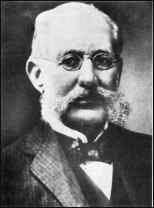
Dr. Carlos Finlay
Juan Carlos Finlay was born in Puerto Principe (now Camagüey) on December 3, 1833. His father, Scottish physician Edward Finlay, an ophthalmologist (eye treatment specialist), had moved to Cuba two years earlier with his French wife, Eliza de Barrés. Shortly after arriving in Cuba, they formally changed their names to Isabel and Eduardo to show how much they loved their new country.
In 1847, at the age of 13, Juan Carlos was sent to Germany to begin his primary studies, and later to the town of Rouen in France, where his father had studied medicine. When he returned to Cuba as a teenager, he asked to legally change his name to Carlos Juan, as a way to further embrace his Cuban identity.

In 1851 Carlos attended Jefferson Medical College in Philadelphia, Pennsylvania. He graduated in 1855, and completed his studies in Havana, and in Paris. Afterwards he settled in Cuba and opened a medical practice.
In 1865 Dr. Finlay sent a paper to the Academy of Sciences in Havana outlining his theory on weather conditions and the yellow fever disease. He was the first to theorize that a mosquito was the way by which yellow fever was transmitted; a mosquito that bites a victim of the disease could bite a healthy person and spread the disease.
When the Ten Year War began in 1868, Dr. Finlay (known to Spaniards as a rebel sympathizer) went to live in Trinidad. He returned to Cuba in 1870, and in 1879, he got a chance to work with the first American Yellow Fever Commission. He spent years studying mosquitoes, and refining his theories. Of his more than 100 scientific articles for medical conferences and journals, over 70 were about the yellow fever disease, which had caused thousands of deaths in Cuba.
In 1871 he spoke at medical conferences in Havana and Washington, D.C., but his theory of mosquito transmission of the virus met with silence from the medical and scientific community.
In 1900, during the first U.S. occupation of Cuba, a U.S. medical commission led by Dr. Walter Reed went to Havana to study the disease. At first the U.S. scientists didn't pursue Dr. Finlay's "mosquito" theories, certain that it was "filth" that spread the yellow fever virus.
When all their experiments failed, they began to look over Dr. Finlay's 19 years of research. Eventually they concluded that yellow fever is contagious only in the first 3 days of illness, and this became the first layer of proof for Dr. Finlay's theory.
When Dr. Reed proved that Dr. Finlay had been right all along, mosquito control programs were introduced throughout Cuba, (and in the Panama Canal zone, where worked had stopped due to yellow fever outbreaks and many deaths) and the disease brought under control.
Sadly, however, Dr. Reed's original report failed to even mention Dr. Finlay's theories and/or research, and it wasn't until 1954 (39 years after Dr. Finlay's death) that the International Congress of Medical History granted him the proper credit.
Related:
The War for
Cuban Independence | U.S.
Occupation of Cuba